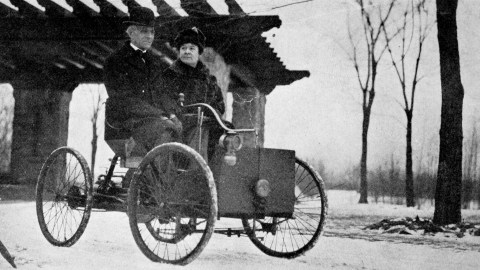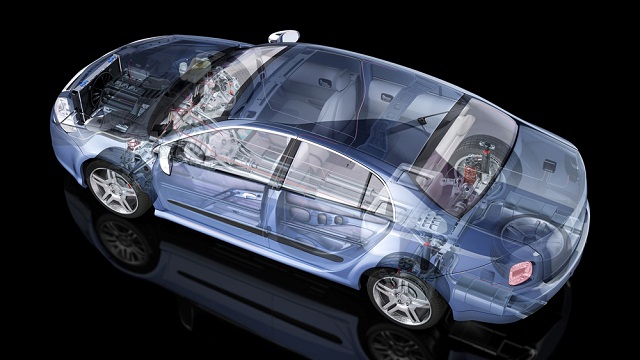Why the Model T was Henry Ford’s epic poem

- Henry Ford built the most influential car in the world on the basis of engineering and marketing ideas that could not be disentangled from his personality, his opinions, his prejudices, and his economic theory.
- He was a populist of genius. One biographer, Steven Watts, writes of “a love affair between a pioneering automaker from Detroit and common Americans that transcended all reason.”
- Ford might not be the most successful car magnate of all time – that title surely goes to Alfred Sloan of General Motors – but he was certainly the most interesting.
Excerpted from The Car: The Rise and Fall of the Machine that Made the Modern World, by Bryan Appleyard. Pegasus Books, 2022.
To the casual contemporary gaze the Ford Model T just looks like a comical old car: black with a high, ungainly passenger box – men kept their hats on in those days – a small engine compartment, prominent lamps, mudguards and running boards, all bolted on without a thought of aerodynamic efficiency. It is a car that, especially in coupe form, seems to be walking on tiptoes. This two-box design – engine bay and passenger compartment – immediately evokes cars from the early twentieth century right through to the thirties and the forties. It was preceded by the tricycle or horseless-carriage styles and succeeded by the three-box style of the saloon/sedan with a large boot at the rear. That, in turn, was to be succeeded by the two-box sport-utility vehicle.
The striking thing about the T is the transparency, the naked display of its own construction. The workings of the car are almost all visible and it looks as though it could be taken apart with one screwdriver and one spanner. Other cars of the period made some effort to look like integrated wholes; the T flaunts itself as a compilation of parts. And, indeed, parts defined the consumer experience of the car. By the 1920s, when sales were at their peak, the Sears Roebuck catalogue offered 5,000 accessories that could be bolted on to the family T, including a “de-luxe flower vase of the cut-glass anti-splash type.”
The car inspired affection in its owners. The T rapidly acquired nicknames: Tin Lizzie, flivver – a word of indeterminate origins – or jalopy, which might be derived from Jalapa, a Mexican town where many old cars were sent to be turned into scrap.
The T, as it aged, became comical because of its illusory appearance of fragility. In the Laurel & Hardy film Slippery Pearls (aka The Stolen Jools) Ollie is driving a T and Stan is in the passenger seat. In the rear seat is a smart-looking man in a hat. A siren is wailing. Stan attempts to push a button on the dashboard but Ollie slaps his hand away. The car pulls up and, once again, Stan reaches for the button. This time he is unimpeded and the button is pressed. There is a sharp cut away so we can see the whole car just as it collapses into its constituent pieces. All three are flung backwards. Stan recovers looking confused and Ollie wearily readjusts his bowler hat. The smart man in the back rises from the wreckage, dusts himself off and, as if nothing had happened, as if cars were expected to fall apart when they parked, says, “Thank you, boys, where’d you be when I need you?” “Right here,” says Ollie, pointing downwards at the now immobilised wreckage.
The film was made in 1931, four years after the end of Model T production. Stan and Ollie’s machine certainly looks like a Tin Lizzie – unkempt, fragile – though the totality of its collapse goes way beyond anything that might have been expected of any ordinary jalopy.
But such jokes were only possible because by then everybody knew about the T. It was eulogised and sung about. In a way never achieved before or since, the word “car” meant this car; it had a cultural presence greater than any music or film star. In 1922 E.B. White was just out of college and looking for something to write about. That same year Scott Fitzgerald and Ernest Hemingway had gone to find themselves in Paris – a very retro move, as if old Europe were still in charge. White chose, modernistically, to drive across America in a T, an experience that became two essays – “Farewell to Model T” and “From Sea to Shining Sea.” He did not see the T as a jalopy; he saw it as a technological masterpiece and, most importantly, a new way of life: “Mechanically uncanny, it was like nothing that had ever come to the world before…My generation identifies it with youth, with its gaudy irretrievable excitements.”
That last sentence tells us to look more carefully at this car. It was not always a cranky old-timer, an eccentric jalopy. On the contrary, it was once about youth and gaudy excitements. It compares with sixties cars like the Ford Mustang or the BMC Mini, emblems of both the threat and the charm of youth culture. But the message of the T was more astounding than the symbolism of either of those two cars. For what it said, in the still horse-drawn year of 1908, was: everybody can have a car. When production ended in 1927 and the 15 millionth T rolled off the production line, it was clear that everybody could, indeed, have a car.
Considered as a business proposition the T was absurd. Produced between 1908 and 1927, it was the only car then made by the Ford Motor Company. Any contemporary executive would say this one product strategy was madness, a ludicrously high risk. But to Henry Ford in his most puritan mode the T was perfect, the only car people would ever need, and, for a surprisingly long time, he was right. He even intended it to last a lifetime, another commercial madness – the ideas of planned obsolescence and annual model upgrades were yet to infect the car industry. The final madness was that he kept reducing the price; the first basic T cost $825, the last $360 after having dipped as low as $260. Again, he was right: he still made money. Other cars have since sold more – the Toyota Corolla in various iterations sold 44 million, the Volkswagen Beetle 22 million and so on – but the Ts were sold in their millions when there were very few cars in the world. And, more to the point, there was only one Henry Ford.
In his memoir, My Life and Work published in 1922, Ford quotes a speech he made in 1907. It is a summary of the T’s business plan:
“I will build a motor car for the great multitude. It will be large enough for the family but small enough for the individual to run and care for. It will be constructed of the best materials, by the best men to be hired, after the simplest designs that modern engineering can devise. But it will be so low in price that no man making a good salary will be unable to own one—and enjoy with his family the blessing of hours of pleasure in God’s great open spaces.”
But this wasn’t Ford; it was Samuel Crowther. Crowther, a journalist, “ghosted” the memoir as well as three other Ford books. Here Ford seems to be quoting himself, but this is a writer’s, not an engineer’s, paragraph – clipped, precise and rousing. I would be prepared to bet that the word “multitude” in the first sentence is Crowther’s oblique reference to a famous line from Walt Whitman’s “Song of Myself” – “I am large, I contain multitudes.”
And Ford did contain multitudes. His lifespan is neatly bracketed by two of the most momentous events in American history. Born in 1863 four weeks after the Battle of Gettysburg, the most decisive and bloody battle of the Civil War, he died in 1947, having witnessed the defeat of Japan by the first and so far only deployment of nuclear weapons in war.
In opinion and attitude he could be all things to all men. He was a vicious anti-semite and then, for a time, he wasn’t; he was puritanical and yet extravagant; he was a man of peace and then of war; he was a philanthropist and a cruel hoarder; he loved his son Edsel and he tortured him; he was an enlightened boss but he became a global emblem of cold, grinding capitalism. Anything, good or bad, about Henry Ford can be contradicted except the ambition and the work. Two hundred years before he was born, the poet John Dryden captured Ford in a couplet:
A man so various, that he seem’d to be
Not one, but all mankind’s epitome…
He was a populist of genius. One biographer, Steven Watts, writes of “a love affair between a pioneering automaker from Detroit and common Americans that transcended all reason.”
In 1919 Ford pursued a libel case against the Chicago Tribune, which had called him an “ignorant idealist” and “an anarchistic enemy of the nation” because of his opposition a few years earlier to President Wilson’s decision to send the National Guard to the Mexican border to prevent raids by Pancho Villa’s guerrillas. The Tribune’s defense was that Ford was an ignoramus.
On the witness stand Ford did indeed display remarkable ignorance – he thought the American Revolution had occurred in 1812 and that chilli con carne was a large mobile army. He was widely mocked, but he didn’t care. In fact, he revelled in the scorn, as it put him in touch with the common man. “I rarely read anything except the headlines,” he said. “I don’t like to read books; they muss up my mind.”
He was admired for his lack of pretension and his insistence that he was too busy working to educate himself. Those who mocked him could be dismissed as snobs. Preachers offered prayers to deliver him from these people, and farmers and labourers sent him letters of support. As a result, what would have been embarrassing to a lesser man became for Ford an assertion of his status as an American folk hero. He won the case.
The populist simplicity of the values evoked in Crowther’s paragraph and proved in the court case is deceptively straightforward: family, good and accessible products, simplicity in use, low price and, crucially, “God’s great open spaces.” That last attribute is the only one that offers an answer to the question, what is a car for? It also points to the most striking of Ford’s paradoxes: in providing access to God’s open spaces, the car would threaten their continued existence.
But that unfortunate side effect was only to become apparent years later. For Ford the creation of the greatest of all “people’s cars” was entirely consistent with his homespun values. Values that for him were embodied, first, in his mother and, second, in McGuffey Eclectic Readers, school textbooks published between 1836 and 1960. These imparted not just basic education but also the values of honour, integrity, temperance, kindness, hard work, patience and so on. The books stayed with Ford throughout his life. In 1934 he moved the log cabin where William Holmes McGuffey was born to Greenfield Village, his outdoor history museum in Dearborn. He had also created the largest private collection of McGuffeys in the USA. “The McGuffey Readers,” he said, “taught industry and morality to the youth of America.”
Ford might not be the most successful car magnate of all time – that title surely goes to Alfred Sloan of General Motors – but he was certainly the most interesting. Sloan’s memoir, My Years with General Motors, is, as the title suggests, paralysingly dull; everything Ford – or Crowther – wrote, said, thought or made, for good or ill, was stunningly interesting. Ford built the most influential car in the world on the basis of engineering and marketing ideas that could not be disentangled from his personality, his opinions, his prejudices and his economic theory. The car, like the man, contained multitudes. Or, to put it another way, the Model T was the autobiography Ford wrote without the aid of Crowther. Or, to put it yet another way, it was his epic poem.
“No poet,” said the great nature writer John Burroughs, one of his friends and mentors, “ever expressed himself through his work more completely than Mr. Ford has expressed himself through his car.”





